Joel Faflak
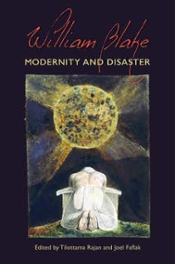 William Blake: Modernity and Disaster
William Blake: Modernity and Disaster
William Blake: Modernity and Disaster explores the work of the Romantic writer, artist, and visionary William Blake as a profoundly creative response to cultural, scientific, and political revolution. In the wake of such anxieties of discovery, including the revolution in the life sciences, Blake’s imagination – often prophetic, apocalyptic, and deconstructive – offers an inside view of such tumultuous and catastrophic change.
A hybrid of text and image, Blake’s writings and illuminations offer a disturbing and productive exception to accepted aesthetic, social, and political norms. Accordingly, the essays in this volume, reflecting Blake’s unorthodox perspective, challenge past and present critical approaches in order to explore his oeuvre from multiple perspectives: literary studies, critical theory, intellectual history, science, art history, philosophy, visual culture, and psychoanalysis. Covering the full range of Blake’s output from the shorter prophecies to his final poems, the essays in William Blake: Modernity and Disaster predict the discontents of modernity by reading Blake as a prophetic figure alert to the ends of history. His legacy thus provides a lesson in thinking and living through the present in order to ask what it might mean to envision a different future, or any future at all. 2020, Toronto University Press.
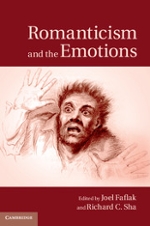 Romanticism and the Emotions (editor)
Romanticism and the Emotions (editor)
There has recently been a resurgence of interest in the importance of the emotions in Romantic literature and thought. This collection, the first to stress the centrality of the emotions to Romanticism, addresses a complex range of issues including the relation of affect to figuration and knowing, emotions and the discipline of knowledge, the motivational powers of emotion, and emotions as a shared ground of meaning. Contributors offer significant new insights on the ways in which a wide range of Romantic writers, including Jane Austen, William Wordsworth, Immanuel Kant, Lord Byron, Mary and Percy Bysshe Shelley, Thomas De Quincey and Adam Smith, worried about the emotions as a register of human experience. Though varied in scope, the essays are united by the argument that the current affective and emotional turn in the humanities benefits from a Romantic scepticism about the relations between language, emotion and agency. 2014, Cambridge.
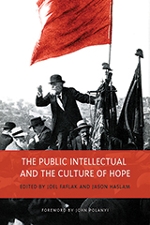 The Public Intellectual and the Culture of Hope (editor)
The Public Intellectual and the Culture of Hope (editor)
The Public Intellectual and the Culture of Hope brings together a number of winners of the Polanyi Prize in Literature – a group whose research constitutes a diversity of methodological approaches to the study of culture – to examine the rich but often troubled association between the concepts of the public, the intellectual (both the person and the condition), culture, and hope. The contributors probe the influence of intellectual life on the public sphere by reflecting on, analyzing, and re-imagining social and cultural identity.
The Public Intellectual and the Culture of Hope reflects on the challenging and often vexed work of intellectualism within the public sphere by exploring how cultural materials – from foundational Enlightenment writings to contemporary, populist media spectacles – frame intellectual debates within the clear and ever-present gaze of the public writ large. These serve to illuminate how past cultures can shed light on present and future issues, as well as how current debates can reframe our approaches to older subjects. 2013, University of Toronto Press.
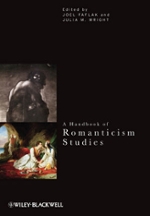 The Handbook to Romanticism Studies (editor)
The Handbook to Romanticism Studies (editor)
A Handbook of Romanticism Studies features a collection of original essays by leading scholars, examining the literature of the Romantic period through the lens of critical and cultural theory. The entries explore key terms organized under the headings of Aesthetics and Media, Theories of Literature, Ideologies and Institutions, and Disciplinary Intersections. Some of these terms have been central to Romanticism studies for some time, such as imagination, sublime, and poetics. Other terms reflect critical trends of the last thirty years, including philosophy, race, historiography, and visual culture. The result is a collection which provides both introductory overviews and in-depth analyses of a variety of topics, offering a wide range of entry points to the study of Romanticism, from debates over the formal properties of high art to the impact of philosophical and scientific debates on conceptions of culture and cultural works. A Handbook of Romanticism Studies is an accessible and indispensible resource providing both students and scholars with a rich array of historical and up-to-date critical and theoretical contexts for the study of the literature and culture of the Romantic period. 2012, Wiley Blackwell.
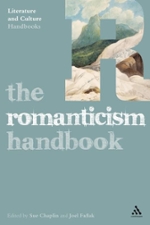 The Romanticism Handbook (editor)
The Romanticism Handbook (editor)
The Romanticism Handbook is an accessible and comprehensive introduction to literature and culture in the Romantic period. It is a one-stop resource for literature students, providing the essential information and guidance needed from introducing the historical and cultural context to key authors, texts and genres. It includes case studies for reading literary and critical texts, a guide to key critical concepts, introductions to key critical approaches, and a timeline of literary and cultural events. Essays on changes in the canon, interdisciplinary approaches and current and future directions in the field lead into more advanced topics; and guided further reading enables further independent work. Written in clear language by leading academics, it is an indispensable starting point for anyone beginning their study of Romantic literature. 2011, Bloomsbury.
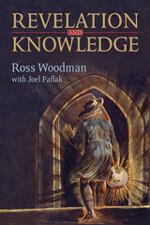 Revelation and Knowledge: Romanticism and Religious Faith
Revelation and Knowledge: Romanticism and Religious Faith
Woodman and Joel Faflak focus on the clash in these authors' works between depth psychology and mysticism in the context of post-Enlightenment crises of belief. They also delve into the treatment of revelation in Romantic poetry, expanding on the concept through nuanced examinations of specific Eastern and Western religious traditions. Revelation and Knowledge showcases Woodman's trademark ability to combine literary criticism with autobiography, resulting in a surprising work that is also uniquely daring. 2011, University of Toronto Press.
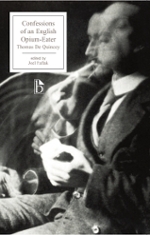 Confessions of An English Opium-Eater, by Thomas de Quincey (editor)
Confessions of An English Opium-Eater, by Thomas de Quincey (editor)
Confessions of an English Opium-Eater remains its author's most famous and frequently-read work and one of the period's central statements about both the power and terror of imagination. De Quincey describes the intense "pleasures" and harrowing "pains" of his opium use in lyrical and dramatic prose. A notorious success since its 1821 publication, the work has been an important influence on philosophers, theorists, and psychologists, as well as literary writers, of the nineteenth and twentieth centuries. But Confessions is only one part of a larger confessional project conceived by De Quincey over the course of his writing career. Gathered together in this edition, these texts provide a fascinating glimpse of early nineteenth-century British aesthetic, medical, psychological, political, philosophical, social, racial, national, and imperialist attitudes.
This is by far the best paperback edition of De Quincey's Confessions ever to be published. Joel Faflak's comprehensive introduction demonstrates both why De Quincey is fascinatingly of our own moment, and how he speaks to the complex interplay between the literary avant-garde and imperialist geopolitics during the early nineteenth century. The text is thoroughly annotated and its abundant allusions explained. Especially useful are the appendices that locate the Confessions in literary, social, and political history, illuminating the role played by the opium trade in Britain's colonial mission, as well as how opium use was understood in the medical literature of the time. Faflak's expert editing gives us a De Quincey who is richer and stranger than ever before. 2009, Broadview Press.
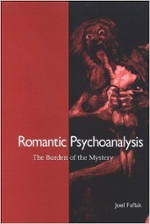 Romantic Psychoanalysis: The Burden of the Mystery
Romantic Psychoanalysis: The Burden of the Mystery
In this provocative work, Joel Faflak argues that Romanticism, particularly British Romantic poetry, invents psychoanalysis in advance of Freud. The Romantic period has long been treated as a time of incipient psychological exploration anticipating more sophisticated discoveries in the science of the mind. Romantic
Psychoanalysis challenges this assumption by treating psychoanalysis in the Romantic period as a discovery unto itself, a way of taking Freud back to his future. Reading Romantic literature against eighteenth- and nineteenth-century philosophy, Faflak contends that Romantic poetry and prose—including works by Coleridge, De Quincey, Keats, and Wordsworth—remind a later psychoanalysis of its fundamental matrix in phantasy and thus of its profoundly literary nature. 2009, SUNY Press.
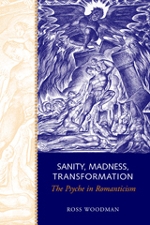 Sanity, Madness, Transformation: The Psyche in Romanticism (editor)
Sanity, Madness, Transformation: The Psyche in Romanticism (editor)
In Sanity, Madness, Transformation, Ross Woodman offers an extended reflection on the relationship between sanity and madness in Romantic literature. Woodman is one of the field's most distinguished authorities on psychoanalysis and romanticism. Engaging with the works of Northrop Frye, Jacques Derrida, Sigmund Freud, and Carl Jung, he argues that madness is essential to the writings of William Blake, William Wordsworth, and Percy Shelley, and that it has been likewise fundamental to the emergence of the modern subject in psychoanalysis and literary theory. For Frye, madness threatens humanism, whereas for Derrida its relationship is more complex, and more productive. Both approaches are informed by Freudian and Jungian responses to the psyche, which, in turn, are drawn from an earlier Romantic ambivalence about madness.
This work, which began as a collection of Woodman's essays assembled by colleague Joel Faflak, quickly evolved into a new book that approached Romanticism from an original psychoanalytic perspective by returning madness to its proper place in the creative psyche. Sanity, Madness, Transformation is a provocative hybrid of theory, literary criticism, and autobiography and is yet another decisive step in a distinguished academic career. 2005, University of Toronto Press.
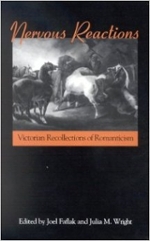 Nervous Reactions: Victorian Recollections of Romanticism (editor)
Nervous Reactions: Victorian Recollections of Romanticism (editor)
Nervous Reactions considers Victorian responses to Romanticism, particularly the way in which the Romantic period was frequently constructed in Victorian-era texts as a time of nervous or excitable authors (and readers) at odds with Victorian values of self-restraint, moderation, and stolidity. Represented in various ways—as a threat to social order, as a desirable freedom of feeling, as a pathological weakness that must be cured—this nervousness, both about and of the Romantics, is an important though as yet unaddressed concern in Victorian responses to Romantic texts. By attending to this nervousness, the essays in this volume offer a new consideration not only of the relationship between the Victorian and Romantic periods, but also of the ways in which our own responses to Romanticism have been mediated by this Victorian attention to Romantic excitability.
Considering editions and biographies as well as literary and critical responses to Romantic writers, the volume addresses a variety of discursive modes and genres, and brings to light a number of authors not normally included in the longstanding category of "Victorian Romanticism": on the Romantic side, not just Wordsworth, Keats, and P. B. Shelley but also Byron, S. T. Coleridge, Thomas De Quincey, Mary Shelley, and Mary Wollstonecraft; and on the Victorian side, not just Thomas Carlyle and the Brownings but also Sara Coleridge, George Eliot, Elizabeth Gaskell, Archibald Lampman, and J. S. Mill. 2004, SUNY Press.
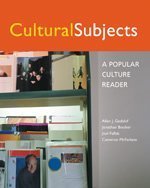 Cultural Subjects: A Popular Culture Reader (editor)
Cultural Subjects: A Popular Culture Reader (editor)
Cultural Subjects: A Popular Culture Reader is a collection of 22 readings by well-known international scholars in various areas of cultural studies. Recognizing that pop culture is a global phenomenon, it features Canadian selections alongside classic writings in the field prefaced by student-friendly introductions. 2004, Nelson College Indigenous.



